Numbers | Chapter 1 | 8th Maths - Square Root | 8th Maths : Chapter 1 : Numbers
Chapter: 8th Maths : Chapter 1 : Numbers
Square Root
Square
Root
Squaring
a number is another mathematical operation just like addition, subtraction, multiplication
etc., Most mathematical operations have ‘inverse’ (meaning ‘opposite’) operations.
For example, subtraction is the inverse of addition, division is the inverse of
multiplication etc., Squaring also has an inverse operation namely finding the Square root.
The square
root of a number n, written √n (or) n1/2, is the number that
gives n when multiplied by itself.
For example,
√81 is 9, because 9 × 9 = 81.
In the adjacent
table, we have square roots of all the perfect squares starting from 1 to 100.
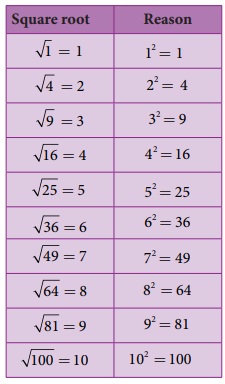
If 112
= 121, what is √121 ? If 529 = 232, what is the square root of 529? If
we know that 324 = 182, we can immediately tell that √324 is 18.
We have,
12 = 1 and so 1 is a square root of 1. Similarly, (–1)2 =
1. So, (–1) is also a square root of 1.
22 = 4 and so 2 is a square root of 4. Similarly, (–2)2 = 4.
So, (–2)
is also a square root of 4.
This continues as 32 = 9 and so 3 is a square root of 9. Similarly, (–3)2 = 9. So, (–3) is also a square root of 9.
The above
examples suggest that there are two integral square roots for a perfect square number.
However, in working out the problems, we will take up only positive integral square
root. The positive square root of a number is always denoted by the symbol √. Thus, √4 is 2 (and not –2). Also, √9 is 3 (and
not –3). We have to remember that this is a universally accepted notation.
1. Square
root through Prime Factorisation
Study the
following table giving the prime factors of numbers and those of their squares.

Look at 6
and its prime factors. How many times do 2 and 3 occur in 36 in the list?
Now, look
at its square 36 and its prime factors. How many times do 2 and 3 occur in 36 here?
Repeat the
above task in the case of other numbers 8, 12, and 15 also. (We may also choose
our own numbers and their squares). What do we find? We find that,
The number of times a prime factor occurs in the square of a
number = twice the
number of times it occurs in the prime factorisation of the number.
We use this
idea to find the square root of a square number. First, resolve the given number
into prime factors. Group the identical factors in pairs and then take one from
them to find the square root.
Example 1.24
Find the
square root of 324 by prime factorisation.
Solution:
First, resolve
the given number into prime factors. Group the identical factors in pairs and then
take one from them to find the square root.
Now, 324
=
2 ×
2 ×
3 ×
3 ×
3 ×
3
= 22 ×32 ×32
= (2 ×3 ×3)2
√324 =
√(2×3×3)2
= 2×3×3
√324 = 18
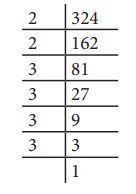
Example 1.25
Find the
least number by which 250 is to be multiplied (or) divided so that the resulting
number is a perfect square. Also, find the square root in that case.
Solution:
Here, 250
= 5 × 5 × 5 × 2
=52×5×2
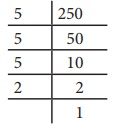
Here, the
prime factors 5 and 2 do not have pairs.
Therefore,
we can either divide 250 by 10 (5 × 2) or multiply 250 by 10.
(i) If we
multiply 250 by 10, we get 2500 = 52 × 5 × 2 × 5 × 2 and therefore the
square root of 2500 would be 5 × 5 × 2 = 50.
(ii)
If we divide 250 by 10, we get 25 and in this case we get √25 =
√52 = 5.
Example 1.26
Is 108 a
perfect square number?
Solution:
Here, 108
=
2 ×
2 ×
3 ×
3 ×
3
= 22
×32
×3
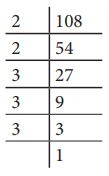
Here, the prime factor 3 does not have a second pair. Hence, 108 is not a perfect square number.
Think
In this case,
if we want to find the smallest factor with which we can multiply or divide 108
to get a square number, what should we do?
Solution:
108 = 2 × 2 × 3 × 3 = 22
× 32 × 3
If we multiply the factors by 2, then we get
22 × 32 × 3 × 3 ⇒ 22 × 32 × 32 = (2 × 3 × 3)2
Which is perfect square.
∴ Again if we divide by 3
then we get 22 × 32 ⇒ (2 × 3)2, a perfect
square.
∴ We have to multiply or
divide 108 by 3 to get a perfect square.
2. Finding
the square root of a number by Long Division Method
When we come
across numbers with large number of digits, finding their square roots by factorisation
becomes lengthy and difficult. Use of long division helps us in such cases. Let
us look into the method with a couple of illustrations.
Illustration 1
Find the
square root of 576 by long division method.
Step 1:
Group the digits in pairs, starting with the digit in the unit’s place. Each pair and the remaining digit (if any) is called a period. Put a bar over every pair of digits starting from the right of the given number.

If there are odd number of digits,
the extreme left digit will be without a bar sign above it.
So, here
we have 5 ![]()
Step 2:
Think of
the largest number whose square is equal to or just less than the first period. Take this number as
the divisor and also as the quotient. The 2 left extreme number here is 5. The largest
number whose square is less than or equal to 5 is 2. This is our divisor and the
quotient.

Step 3:
Bring 76
down and write it down to the right of the remainder 1.
Now, the
new dividend is 176.

Step 4:
To find the
new divisor, multiply the earlier quotient (2) by 2 (always) and write it leaving
a blank space next to it.
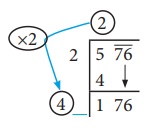
Step 5:
The new divisor
is 4 followed by a digit. We should choose this digit next to 4 such that the new
quotient multiplied by the new divisor will be less than or equal to 176.
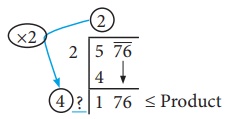
Step 6:
Clearly,
the required digit here has to be 4 or 6. (Why?)
When
we calculate, 46 × 6 = 276 whereas 44 × 4 = 176 .
Therefore,
we put 4 in the blank space and write 44 × 4 = 176 below 176 and subtract
to get the remainder 0 and the quotient at the top, that is 24 is the square root
of 576.
√576
= 24
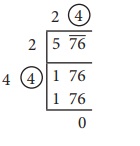
Illustration 2
In
the following example, follow the figures one after another and try to understand
what each figure explains, the stage by stage and the gradual computation of computing
the square root of 288369.
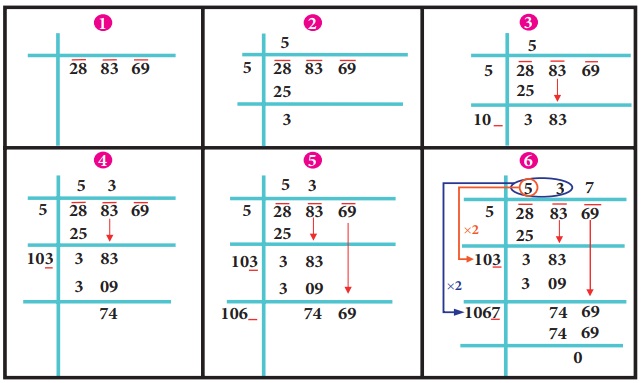
We
find that √288369 =537.
Example 1.27
Find
the square root of 459684 by long division method.
Solution:
By
long division method, we can find the square root of 459684 as given below:
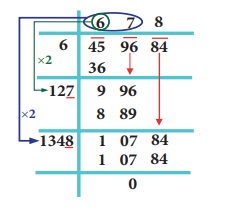
√459684 =
678
Try these
Find the square root by
long division method.
1. 400 2. 1764 3. 9801
Solution:
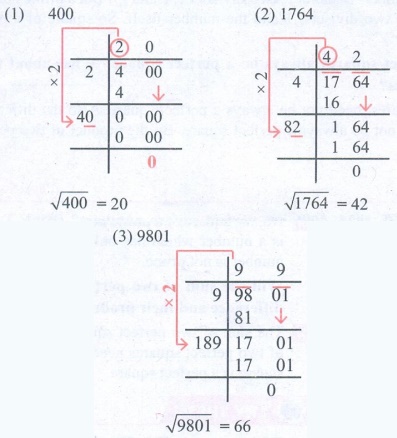
3. Number of digits in the square root of a perfect square number
We
made use of bars to find the square root in the division method. This marking bars
help us to find the number of digits in the square root of a perfect square number.
Observe the following examples (with bars shown as if we compute square root by
division procedure).

Hence,
we conclude that the number of bars indicates the number of digits in the square
root.
Try these
Without calculating the square root, guess the number of digits in
the square root of the following numbers:
1. 14400 2. 390625 3. 100000000
Solution:
(1) √14400 = √[144×100] = √l44 × √100
= 12 × 10 = 120.
(2) √390625 = √ [25 × 25 × 25 × 25]
= √[25×25] × √[25×25] = 25 × 25 = 625
(3) √100000000 = √[10000×10000]
= √10000 × √10000
= 100 × 100= 10,000
4. Square root of decimal numbers
To
compute the square root of numbers in the decimal form, we simply follow the following
steps:
Step 1:
Make
even number of decimal places even by affixing a zero on the extreme right of the
digit in the decimal part (only if required).

To find √42.25
Step 2:
The
number has an integral part and a decimal part. In the integral part, mark the bars
as done in the case of division method to find the square root of a perfect square
number.

We put the bars as √42.25
Step 3:
In
the decimal part, mark the bars on every pair of digits beginning with the first
decimal place.
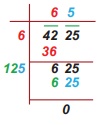
Step 4:
Now, calculate the square root by long division method.
Step 5:
Put
the decimal point in the square root as soon as the integral part is exhausted.
√42.25 = 6.5
5. Square root of product and quotient of numbers
For any two positive numbers a
and b. we have
(i)
√[ab] = √a × √b and (ii) √[a/ b] = √a / √b (b≠0)
Try these
Find the s quare root of
1. 5.4756, 2. 19.36, 3. 116.64
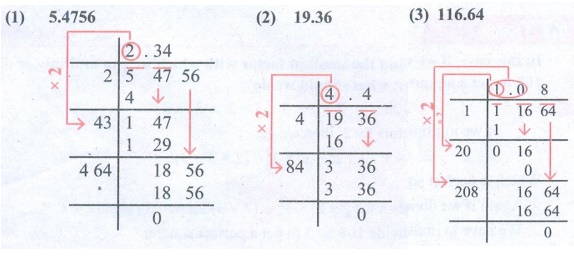
Example 1.28
Find
the value of √256
Solution:
√256 = √[16 × 16] = √16 × √16 = 4 × 4 = 16 (or) √256 = √[64 × 4] = √64 × √4 = 8 × 2 = 16.

Activity
Attempt to prepare a table of square root problems as in the above
case to show that if a and b are two perfect square numbers, then √[a/b] = √a/√b (b ≠ 0). We can use this idea to compute certain
square-root problems easily.
Example 1.29
Find the
value of √42.25 .
Solution:
We can write
this as √42.25 = √[4225/100] = √4225/√100

Now, it is easy to compute the square root of the whole number 4225 by long division method as √4225 = 65 and so, we now get

√42.25 = √[4225/100] = √4225/√100 = 65/10
= 6.5
This is another
way of tackling problems of square root of decimal numbers without any botheration
of decimal symbol.
Try these
Using this method, find the square root of the numbers 1.2321 and
11.9025.
Solution:
(i) √1.2321 = √[12321/10000] = 111/100 = 1.11
(ii) √11.9025 = √119025 / √10000 = 345/100 = 3.45
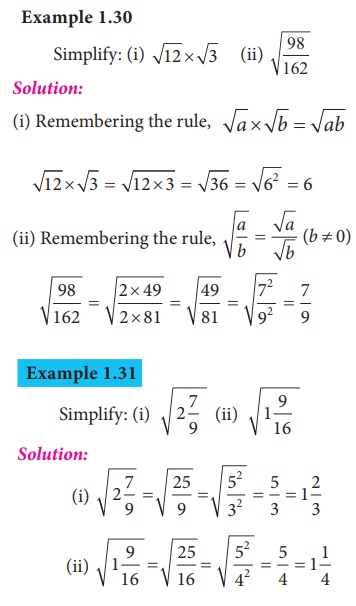
Remark: In the case of the (ii) problem
one may be tempted to give the answer immediately as 1 3/4, but this is not
correct since you have to convert the mixed fraction into an improper fraction and then use the rule

√[a/b] =
√a/√b (b ≠ 0)
6. Approximating
square roots
Can you write
the given numbers √40 , 6 and 7 in ascending order? Here √40 is not a square number
and so we cannot determine its root easily. However, we can estimate an approximation
to √40 and use it here.
We know that
the two closest squares surrounding 40 are 36 and 49.
Thus, 36
< 40 < 49 which can be written as 62 < 40 < 72.
Considering the square root, we have 6 < √40 < 7.
Try these
Write the numbers in ascending order.
1. 4, √14 , 5
2. 7, √65 , 8
Solution:
(i) 4, √14, 5
Squaring all the numbers we get 42, (√l4)2,
52 ⇒ 16, 14, 25
∴ Ascending order : 14, 16, 25
Ascending order : √14, 4, 5
(ii) 7, √65, 8
Squaring 7, √65 and 8 we get 72, (√65)2 ,
82 ⇒ 49, 65, 64
Ascending order : 49, 64, 65
Ascending order : 7, 8, √65
Related Topics